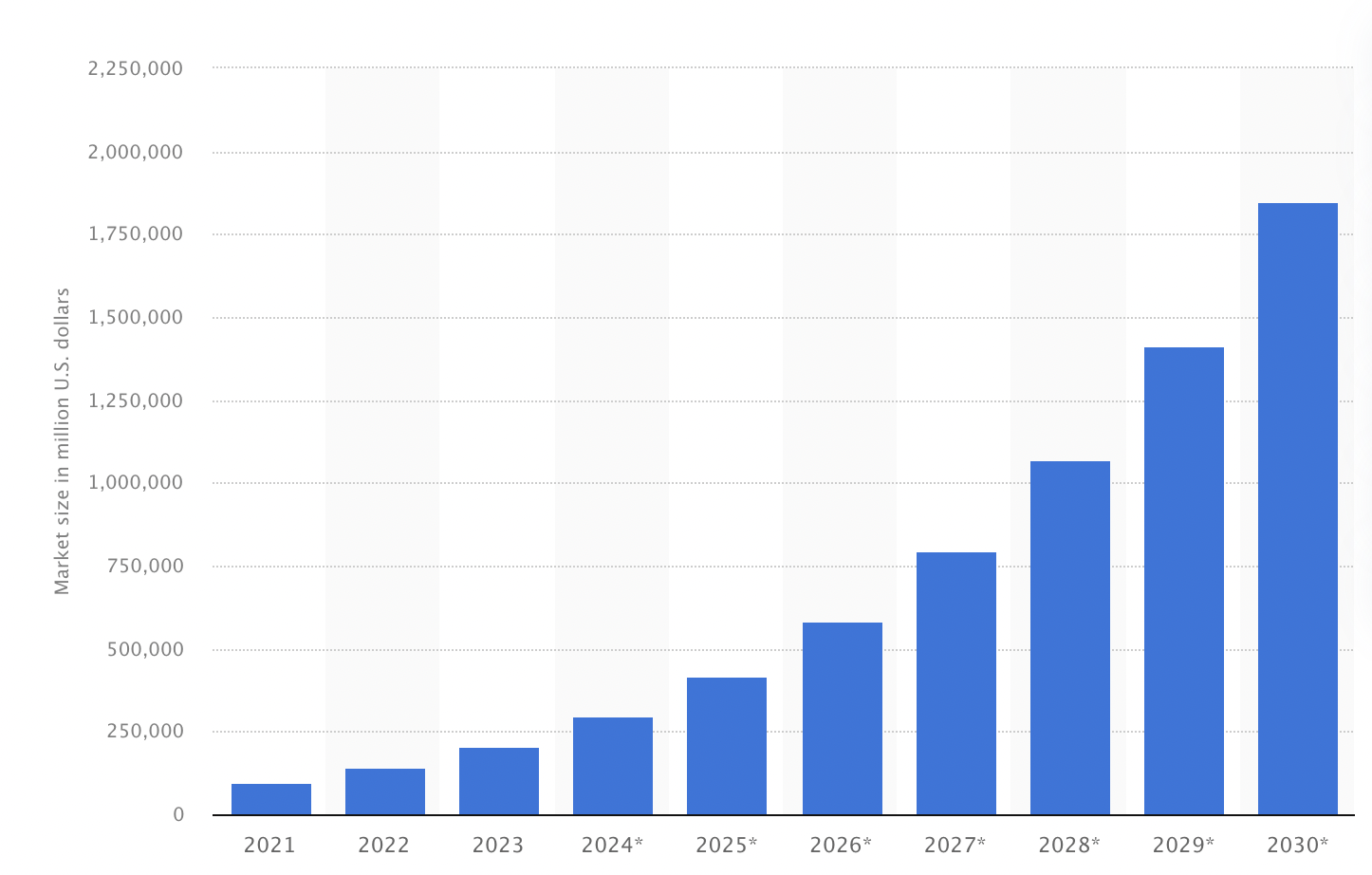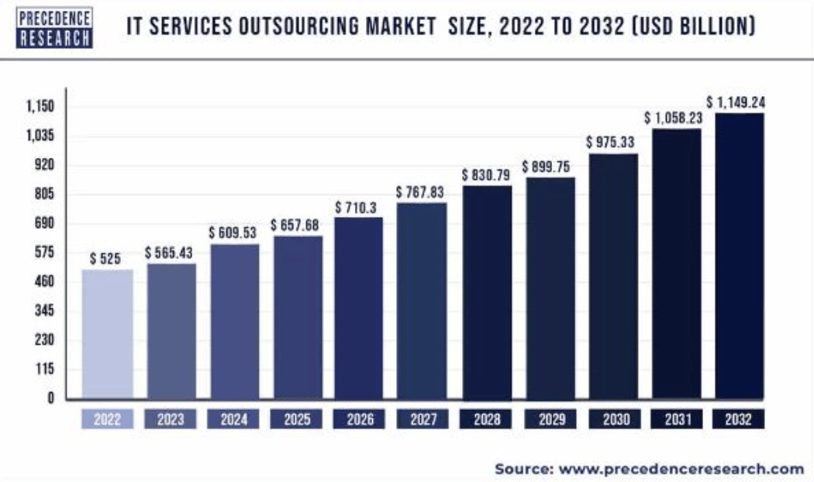Quick Summary: The IT field is changing quickly. Key technologies such as AI, cloud computing, blockchain, cybersecurity, and quantum computing are at the forefront of digital transformation. This blog explores 20+ emerging IT trends that are shaping the future of businesses, innovation, and digital transformation.
The world of information technology is evolving faster than ever. It is driving business transformation with smarter automation to create enhanced digital experiences.
From IT outsourcing services to AI development, cloud advancements, and cybersecurity innovations, these emerging trends are shaping the future of how we work and live.
In this blog, we’ll dive into 20+ cutting-edge IT trends that are redefining the tech landscape and helping businesses stay ahead in a digital-first world.
Key Takeaways
- AI-powered solutions, like generative AI and intelligent automation, are helping industries of all sizes by streamlining workflows and enhancing decision-making.
- Innovations like quantum computing, the metaverse, and next-gen connectivity (5G & 6G) are changing how businesses and consumers interact in the digital era.
- With rising cyber threats, companies are investing in zero-trust security, AI-driven threat detection, and blockchain-powered security frameworks.
25+ Emerging Trends In Information Technology in 2025

The IT industry is always active and on the go. Whatever your interests are, the virtual world has something for you. Here are the top emerging trends in information technology unfolding with their brief encapsulation.
1. Artificial Intelligence and Machine Learning
Artificial Intelligence (AI) and Machine Language (ML) have been unquestionably one of the latest advancements in 2024.
Next Move Strategy Consulting predicts robust growth in the artificial intelligence (AI) market in the upcoming decade. They anticipate a remarkable expansion, with its current valuation of almost 100 billion U.S. dollars projected to increase twentyfold by 2030, reaching close to two trillion U.S. dollars.

Image Source: Statista
Today, you can find AI and ML in every field, from finance and healthcare to manufacturing and retail. The robust AI and ML pair aims to improve, automate, and process time-sensitive data with minimal human interference requirements.
You can accelerate business processes, make informed decisions with an accurate perception of the purchasing behavior, gear the customer experience, and enable chatbots for communication. AI and ML allow you to extract value from piles of data, deliver business insights, automate tasks, ensure safety operations, enhance system capabilities, and implement zero trust security solutions.
Do you want to inculcate AI into your business? Hire AI developers and unlock new possibilities today!
Automate & Optimize with Artificial Intelligence
Stay ahead of the curve by integrating cutting-edge AI technologies into your business.
2. Advanced Analytics
Advanced or predictive analytics generate a predictive model for specific applications, like marketing. It combines Artificial Intelligence and statistical techniques to anticipate outcomes. You can evaluate historical data, identify patterns, and observe trends to determine potential future events before they happen.
It can aid in optimizing processes and performance, reducing risk, increasing asset utilization, and procuring more revenue opportunities, among other features. You can use the model to analyze dynamic market conditions and make strategic decisions, thus improving overall performance.
3. Datafication
Small and large firms across all sectors depend on data. It is safe to say that data underpins modern life; hence, it is vital to secure it. Smartphones, AI devices, industrial machines, etc., use data to communicate with humans and enhance lifestyles. Today you can transmute some aspects of your life into devices and software via data.
Datafication means converting human chores into data-driven technology. It transforms labor-intensive and manual procedures into digital devices powered by data. You can use real-time information to change social behavior into quantified data and improve customer experience.
4. Robotic Process Automation
Robotic Process Automation (RPA) has been slowly gaining ground over the past decade. It utilizes various applications and software to automate manual tasks. You can lower expenses by automating data collection, analysis, and customer service.
In addition to reducing costs, you can focus on critical tasks by using bots to handle repetitive operations. It leads to an efficient workflow and better performance. Almost 95% of firms using Robotic Process Automation (RPA) admit that it improved productivity.
Learn More: An Ultimate Guide To RPA (Robotic Process Automation)
5. Augmented and Virtual Reality
The virtual reality gaming industry and augmented reality have revealed that humans are open to the idea of escaping the real world. Virtual Reality (VR) and Augmented Reality (AR) are modifying how you use screens and unlock the door to engaging and interactive experiences. Unsurprisingly, the VR and AR market may accumulate revenue worth US$46.6bn in 2025.
VR and AR technologies create and augment a captivating virtual environment and real-world scene. Virtual Reality places you inside a computer-generated landscape using a headset. Meanwhile, Augmented Reality plucks digital elements and puts them in your surroundings via a smartphone or visor. While Virtual Reality predominantly transforms the gaming universe, Augmented Reality is used more widely in training and education, marketing and advertising, retail, tourism, and entertainment.
6. IT Outsourcing
IT outsourcing is undergoing rapid and expansive growth, and this trend is projected to continue well into the foreseeable future. Recently, outsourcing in India has emerged in various industries as the most viable choice. Today, businesses are shifting their attention to enhancing their operations in centers located in India to increase profitability.
Reports indicate that nearly 64% of US businesses outsource at least one IT service, each with their unique objectives in mind.
According to a report from MarketsandMarkets, the motivation behind outsourcing IT services includes cost reduction, heightened efficiency, and access to specialized skills. Approximately 32.2% of companies outsource to trim their overall costs, while 20% seek access to innovation. Another 15.4% outsource to enhance the quality of their operations.
It's not surprising, as studies suggest that companies can achieve savings between 70 to 90 percent in their overall labor costs by outsourcing their development operations

The IT outsourcing market size is expected to reach USD 1149.24 billion by 2032, with a current size of USD 565.43 billion and a CAGR of 8.2%. However, this trend is going to flourish in the coming years, as statistics suggest.
Solve Your IT Challenges with "Your Team" In India
Tired of IT headaches? Our experts provide tailored solutions, freeing you to focus on what matters most.
7. Low-Code Technology
Low code is a visual technology trend that presents a quicker and easier software development process. 81% of companies believe that low code development is strategically important for their organization. Low code reduces hand-coding and features interactive tools to streamline app creation.
By minimizing hand-coding and utilizing interactive tools, low-code platforms streamline app creation, allowing you to build customer service tools like AI chatbot development and other applications quickly.
With built-in templates and drag-and-drop functionality, low-code significantly accelerates time-to-market and enhances customer satisfaction through intuitive navigation controls.
8. Natural Language Processing
Financial marketing is the number one Natural Language Processing (NLP) user. The technology obtains data from repositories, shares valuable insights into market sentiment, and informs about tender delays and closings.
NLP empowers computers to comprehend text and words the same way humans can. It assists in machine processes and equips devices to perform mundane tasks themselves. A few examples of NLP include spell check, ticket classification, and summarization.
Large Language Models, like ChatGPTs or Google's PaLM, have taken the world of artificial intelligence by storm. If you are also at square one and planning to learn how to build large language models, this is the right time for you!
9. CyberSecurity
The advent of computers and the internet formulated a new digital cyber sphere. A cyberattack occurs every 39 seconds. The increase in attacks, data breaches, and threats only underscores the need for a viable solution. And when it comes to AI in cybersecurity, the requirement for ethical use and meeting industry standards is crucial. The old saying, “prevention is better than cure," fits well in the cyber world, where businesses lose $188,400 on cybercrime recovery.
Cybersecurity is a must-have for all internet users. You would not want to leave your computer and virtual data open for hackers, yes? Firewalls, antivirus software, and other software gain momentum as developers equip the earlier versions with cutting-edge technologies and features.
10. Cloud Computing and Migration
Are you looking to improve your agility to develop better workload management? Cloud computing or migration is the key! Around 80% of enterprises leverage multiple public or private cloud services. It enables efficient compliance processes, business operations, and data analysis.
Cloud computing blends software, business models, platforms, and critical infrastructure together. Thus, you can maximize seamless adaptability, increase time to value, and meet the current demands of your industry.
11. Blockchain
You are not alone if you think of Bitcoin the minute someone says blockchain! It is understandable, seeing how banking and financial institutions were the first to explore its potential and benefits. However, blockchain is not all about digital currency!
It is a distributed ledger technology that records and tracks transactions and assets in the corporate. Gartner forecasts blockchain technology will generate over $3.1 trillion in business value by this decade. The decentralized model can manage credit risk and ensures immutable, safe, and private customer profiling. It promotes transparency and accountability in online transactions and asset ownership.
Say you are a part of the manufacturing sector. You can use blockchain technology to engineer a supply chain management system. The supply chain management platform will track goods, offer better visibility to business users, and record the processes.
12. Internet of Things
The IoT is a network of objects containing software, sensors, or other technical components. It minimizes human intervention and facilitates connection and data exchange between these devices or objects. The vast potential of IoT promises to add value to daily business operations.
The global Internet of Things (IoT) market is expected to almost double in value over the next five years. It will grow at a rate of 13.5 percent each year, which is expected to increase to $1.8 trillion in 2028.

13. Offshore Software Development Services
The increasing demand for enterprises to stay competitive in the fast-changing digital environment drives growth in offshore software development.
The remarkable expansion in the IT sector is primarily attributed to the indispensable role played by outsourced software development in fulfilling this growing demand. The significant cost associated with software development has led businesses to increasingly offshore their software development projects.
The Offshore Software Development Market is poised for substantial growth, projected to USD 283,457.5 Million by 2030. This growth is expected to be driven by a robust Compound Annual Growth Rate (CAGR) of 10.13% from 2022 to 2030.
Extend Your Team Globally: 24/7 Offshore Development
Benefit from round-the-clock development support with our global team of skilled offshore professionals.
Furthermore, various trends, including AI-powered development, cloud computing, decentralized and remote team environments, and software development security, are the emerging trends in ICT that are set to be pivotal in offshore software development.
These trends are anticipated to contribute significantly to the market's expansion, offering scalability and flexibility. The Global Offshore Software Development Market report comprehensively assesses the market landscape, and offshore development services are expected to go a long way.
14. Edge Computing
Edge computing is probably one of the least acknowledged but the latest IT trend. Gartner predicts that 75% of companies will use Edge to create and process enterprise-generated data by 2025. Edge computing is comprised of computation near the data generators at the network edge. The paradigm processes data closer to where you generated it.
It results in faster processing and excellent action-led output in real-time. With edge computing, you can process data from remote locations using a device or a local server. Further, it reduces latency and stores data in a centralized location when processing it in data centers.
15. Genomics
Modern technologies influence every aspect of businesses today. Of course, healthcare and medicine are no exception. Digital tools, like X-rays, have been around for a while and allow you to diagnose defects in bones and joints. But can you leverage technology to analyze your DNA and beat off diseases? Absolutely!
Genomics technology studies your DNA and genes' makeup and maps them. It also simplifies the diagnosis process and allows doctors and skilled professionals to detect possible health issues before they become critical. It involves technical analysis, design, and diagnostics, besides theoretical research.
Also Read: Top 13 Applications Of Artificial Intelligence In The Healthcare Industry
16. Gen AI
Generative AI is the trending talk of the town in 2025. If we talk about delivering immersive user experiences and creating more human-like content, Generative AI is taking the lead in the emerging technologies list.
The advancements in generative AI models, such as multimodal systems and ChatGPT, have increased the demand for technological expertise.

As per the Grandview research, the Gen AI market size is expected to grow at a CAGR of 37.6% from 2025 to 2030.
As the use of AI technologies is expanding, like text-to-image conversion tools, text-to-video conversions, and even modernizing workflows, everything is contributing to the growing need for Gen AI development solutions to handle everything like a breeze. This showcases the importance of AI-driven solutions to enhance operational efficiency and innovation across varied industries.
17. Voice Activated Technology
With the increasing demand for chatbots to handle everything, voice-activated technology has become more sophisticated. This enables the devices to be able to understand the processes and requirements in a more natural and human-like speech.
Voice-activated technology is more commonly being used in home automation products, customer service bots, and smart speakers. This makes easy technology access with an added touch of convenience.
18. Ambient Invisible Intelligence
Ambient invisible intelligence refers to using small, low-cost tags and sensors to track the location and status of objects and environments. This information then goes to the cloud for analysis and storage. These technologies are built into everyday objects, often without users realizing it.
Gartner predicts that by 2028, early examples of ambient invisible intelligence like retail, logistics will help solve immediate problems. They will enable low-cost tracking and sensing of items, reduce costs, and improve efficiency.
This technology is becoming popular because it offers affordable access to sensors that provide real-time visibility for organizations and supply chain operations.
19. Agentic AI
Agentic AI will soon take center stage in the digital world. Looking ahead to 2025, Agentic AI offers a way to solve problems collaboratively. This means creating AI systems that can work more independently.
According to Gartner, by 2028, at least 15% of day-to-day work decisions will be made autonomously through agentic AI, up from 0% in 2024.
Unlike traditional systems, Agentic AI systems have different levels of independence. They are classified by Agency Level, which shows how much control they have over processes. This ranges from fully autonomous systems to those that still require some human oversight. Agentic AI is changing the field by going beyond standalone Large Language Models (LLMs) in several key ways. This technology uses feedback loops to improve results continually.
By breaking complex tasks into smaller parts, these Agents can plan their actions and use tools and data on their own.

As per the latest data, the interest in research in Agentic AI is increasing, as shown in the graph above. This approach provides a stronger solution than the straightforward processing seen in LLMs. The integration of Agentic AI can change how we interact with technology.
20. Disinformation Security
Disinformation security is an emerging technology category aimed at systematically discerning trust. It can reduce fraud by improving identity validations and preventing account takeovers through ongoing risk assessments and awareness.
From the long-term perspective, not only is it a trending technology, but it can also help protect brand reputation by detecting harmful narratives.
21. AI in Governance
AI governance platforms help manage AI systems to ensure they are used responsibly and ethically. These platforms can allow IT leaders to provide the ethical, transparent, and accountable use of AI.
This alignment helps ensure that AI matches with the organization’s values and societal expectations.

By 2028, businesses using AI governance platforms will earn 30% higher customer trust ratings and 25% better scores for regulatory compliance than their competitors.
As AI technology spreads, so do the risks around using it, such as common biases. Therefore, privacy issues and the need to align with human values are essential. That is why it is crucial to ensure that AI does not harm certain groups, control important systems, or even manipulate markets. AI in governance helps address all this.
22. Multimodal Personal Agents
Multimodal agents will be another constant companion that people rely on in their personal and work lives, similar to how we depend on our cell phones today. These personal agents will understand everything about their users and their lives, including what they see and hear.
Multimodal personal agents will provide real-time, relevant information based on any situation.
23. The Metaverse
The metaverse can change how customers interact with brands, socialize, enjoy entertainment, learn, and take care of their well-being. Companies are trying out virtual stores, digital assets, and immersive environments. These efforts are helping people connect and interact in new ways.
24. Hybrid Computing
Hybrid computing uses different types of tools, like classical computers and special devices, to solve tough problems. Its primary goal is to use the best parts of each tool together.
One major benefit of hybrid computing is its ability to combine advanced technologies like bioinformatics, neuromorphic systems, and quantum computing. For example, generative AI needs a lot of computer power and storage to work on complicated tasks successfully.
25. Quantum Computing Meets AI
Quantum computing and artificial intelligence (AI) combination can work well together. Quantum computers use concepts like entanglement and superposition to change how we develop AI.
The principles of quantum computers, like Grover's algorithm, speed up database searches, which helps AI find patterns more quickly. The Quantum Fourier transform algorithm examines time series data and improves AI by extracting important features from complex datasets.
This combination of quantum computing and AI can make a big difference.
26. Wearable Health Devices
Wearable devices are another emerging trend in information technology. Although we already have several wearables that track health activities. However, the development is still ongoing day by day to improve access to digital health.
Users can now track important health information like heart rate, blood pressure, and sugar levels. These devices can easily connect to smartphones and use AI to analyze the data.
They provide users with insights about their health and early signs of possible health concerns. This trend is moving healthcare towards a focus on prevention and personalized health insights.
27. Spatial Computing
Spatial computing is often seen in futuristic movies. With this, rather than just using a traditional computer at our desks, we can now engage with technology as we go about our daily lives.
Spatial computing includes virtual reality (VR) and augmented reality (AR) but takes them to a new level. It lets you interact with digital elements that blend with the real world.
For example, consider smart homes where you can speak commands to perform tasks or use smart glasses while you move around. This can help you access digital resources while enhancing your real-world experiences.
Conclusion
The Information Technology realm is brutal, to say the least. What you once regarded as a phenomenal solution will become old news in a flash. You must prepare and keep pace with the most recent market trends to take the lead in market growth. As numerous products and services continue to shape the digital world, many new technologies wait for their debut to take it by storm.
Of course, it is not as scary as it sounds. You can always begin by identifying the potential benefits and career options a particular technology delivers. Then, you can see if your preferred one matches your goals. Get on board in the early stages to harness trending information and technology adoption at a rapid pace.
Frequently Asked Questions (FAQs)
Staying on track with the most recent technology trends is the way to a successful business. The correct trend can help you in achieving great heights. It assists in coping with market changes and puts forward a flexible and scalable strategy.
In addition to the mentioned tech trends, computing power, big data analytics, extended reality, digital trust, new energy solutions, 5G, and sustainable tech are among the emerging technologies that will give you a competitive advantage.
With the widespread adoption of technology in healthcare, professionals realize and leverage various latest innovations. Digital twins, cloud computing, personalized medicine, and Digital Health are some of the notable IT products within the industry.
The answer to it varies from one person to another. For the most part, IT trends are a double-sided coin. You would never be bored as tech-savvy with various trends knocking on your door. However, you might feel overwhelmed about which top technology trends to implement and how to get the ball rolling.






